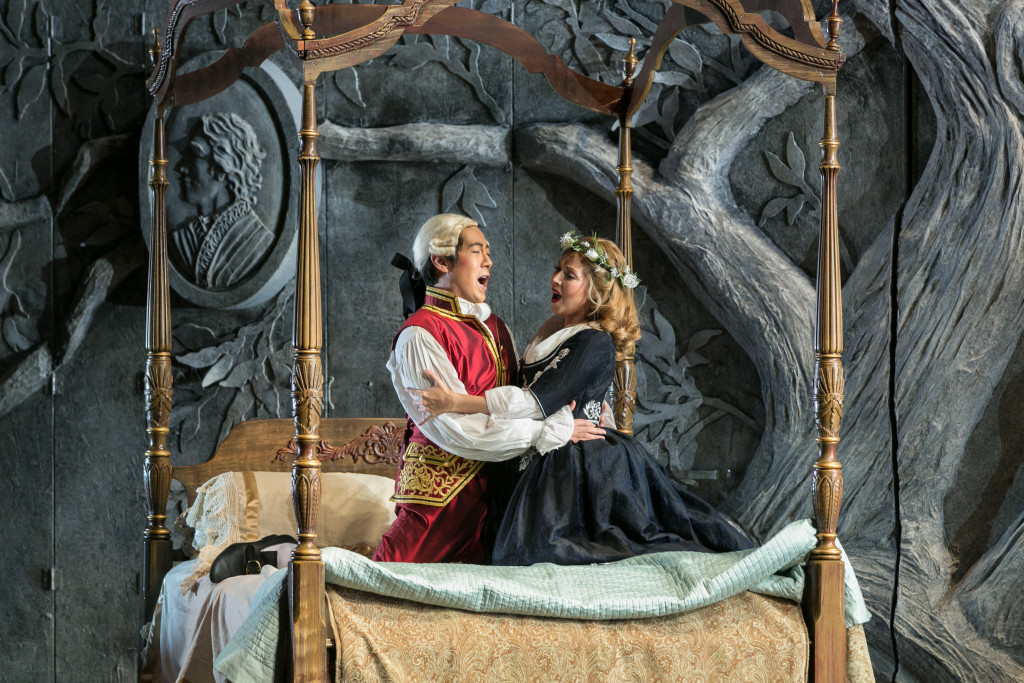By Paul Horsley
The Lyric Opera of Kansas City’s The Marriage of Figaro, which runs through November 13th, bears the marks of a master director: Its fluid, natural interaction of characters, its moments of sly but seldom overplayed wit, and its sharp focus on essential characters at essential moments all keep the mind and the eye engaged. Director Stephen Lawless, a veteran of the world’s major opera stages, even shows discipline in letting us listen to Mozart’s peerless Overture in repose, without some sort of lame pre-curtain pantomime to sap our attention. The result, with fine singing and musical direction and borderline lavish costumes and stage designs, is one of the more distinguished productions of the Lyric’s recent history.

Adam Lau sings Figaro and Maureen McKay is Susanna / All photos by Dana Sohm, courtesy of Lyric Opera of KC
Teaming up with three other companies has permitted the Lyric to gather some serious money for this production, and it shows. Leslie Travers’ scenic and costume designs lend a nod to 18th-century appearances, with expensive-looking chandeliers and richly embroidered gowns in bold hues: Even the servants’ livery is fantastically detailed. The set consists of two large wall segments that are placed at varying angles to create exteriors, interiors or (with the addition of some leafy tree-pieces) the Act IV garden. The “outer” wall is adorned with a bas relief of a tree studded with cameo-style portraits, presumably of members of the Almaviva lineage. When these oval-shaped portraits open to become windows (in which the nobles appear to summon their servants), we realize they are not to be taken literally. The result is a sort of dream-like representation of grand palace life on a smallish scale.
Anyone who thinks 18th-century opera is a genteel affair is forced to reassess this at the very outset of Figaro. The servant Figaro is about to marry the lovely Susanna but his master, Count Almaviva, can’t decide whether or not to exercise his “seigneurial rights” as a nobleman and sleep with the bride before her new husband has a chance to. Ugh, is right. Yet from such twisted roots comedy can indeed grow, and in the spirit of Enlightenment drama this opera is aimed toward delivering the nobleman his comeuppance. That Mozart’s audience found this as satisfying as we do suggests the speed with which society was changing in 18th-century Europe, at around the same time revolution was dawning in France and the US.

Steven Cole (Don Curzio), Edward Parks (Count Almaviva) and Maureen McKay (Susanna)
Yet despite this opera’s title, the lead characters of Figaro are, arguably, the Count and Countess—partly because their roles contain the most vigorous vocal and emotional challenges, perhaps but also because the dramatic forward-motion of this opera is really driven by their coming to terms with the new post-feudal social order.
As such, the Lyric has procured two capital singers for the roles of the melancholy Countess and the lecherous Count. Katie Van Kooten sings her Act II “Porgi amor” with piercing luster, her large voice making Countess Rosina seem bigger-than-life as Thomas C. Hase’s brilliant lighting (featuring a harsh shadow of the couple’s empty marriage-bed looming over her) suggests sadness as well as sexual frustration. The Countess is no wallflower, and although she pines for earlier times in her poignant “Dove sono” later in the opera (complete with generous vocal embellishment), by Act IV she is standing triumphantly on a heap of detritus that seems to represent the ash-heap of her feudal lifestyle.

Edward Parks (Count Almaviva) and Katie Van Kooten (Countess Almaviva)
Edward Parks as the Count looks as if he’s stepped off the set of Pirates of the Caribbean, but he sings like an angel and even when he’s acting like a total jerk (as in his big Act III aria) his golden-warm baritone is so disarmingly gorgeous that it’s difficult to feel much ill toward him. Of course no Figaro can succeed without a good Figaro, and Adam Lau delivers a witty and sophisticated version of the role, despite seeming a tad too “madcap” at times. His voice is small but pleasing, and he demonstrates a tasteful feel for vocal embellishment, though I didn’t feel he opened up fully until his Act IV “Aprite un po’ ” aria.

Katie Van Kooten (Countess), Samantha Gossard (Cherubino) and Maureen McKay (Susanna)
Maureen McKay sang an innocent, lighthearted Susanna, and Steven Cole offered richly comedic “attitude” as both Basilio and Curzio. More interesting still was Samantha Gossard as a spectacularly convincing Cherubino. Looking and acting every bit like an adolescent boy, she nevertheless sang with a gorgeous mezzo-soprano voice, demonstrating a highly developed sense of phrasing and gesture. April Martin sang Barbarina’s “pin” aria with faux seriousness. The orchestral playing under conductor Ryan McAdams was tidy and stylistic, with well-conceived tempos that did not neglect playfulness.
The Marriage of Figaro runs through Sunday, November 13th at the Kauffman Center. Call 816-471-7344 or go to kcopera.org.
To reach Paul Horsley, performing arts editor, send an email to paul@kcindependent.com or find him on Facebook (paul.horsley.501) or Twitter (@phorsleycritic).
[sliderpro id=”2″]
[sliderpro id=”3″]
